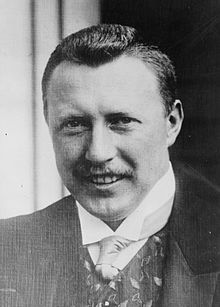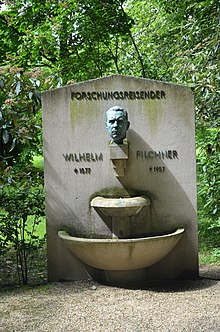Wilhelm Filchner
Wilhelm Filchner (born September 13, 1877 in Munich , according to other information in Bayreuth , † May 7, 1957 in Zurich ) was a German geophysicist , geodesist , explorer and travel writer .
He led the Second German Antarctic Expedition (1911/12) into the Weddell Sea and discovered the Filchner-Ronne Ice Shelf there . He was the author of 27 mainly popular science books and travelogues.
biography
Filchner grew up in Munich with wealthy relatives and joined the cadet corps of the Bavarian army at the age of 15. In 1900 he used a three-month vacation as an ensign in order to undertake his first long journey over Russia , the Caucasus and Kyrgyzstan on his own initiative and with a travel budget of 300 gold marks , on which he finally crossed the Pamirs on horseback .
Filchner studied surveying and geography in Munich, followed by practical training at various military and civil institutions.
The trip had made him famous in Bavaria, and in 1903 he was given the leadership of the expedition for a research trip to Tibet . He was the first researcher to carry out geomagnetic measurements in the Asian country. On the return trip in 1905, the first ideas for a new German Antarctic expedition emerged.
Filchner presented the concrete plans for this second German Antarctic expedition to the public in Berlin in March 1910 . With the help of a lottery, the financial means were quickly raised and a ship was bought.
The research team that Filchner put together, with little polar experience, undertook a small "test expedition" to Spitzbergen in August 1910 . With Erich Przybyllok and four other companions, he crossed the island from Tempelfjord on the west coast to Mohnbukta on the east coast. The route was only 65 km long, but not without danger.
Started from Bremerhaven in May , the expedition ship Deutschland set sail from Buenos Aires on October 4, 1911, towards the South Pole . Since it was not yet known at the time whether the South Pole consists of a coherent mass, they wanted to find a passage across the ice mass or meet a second expedition group by land. This project failed due to bad weather conditions - a newly built wintering station on an iceberg was probably destroyed by a spring tide within a very short time. However, Filchner made some important discoveries, including that of the second largest ice shelf in Antarctica , today's Filchner-Ronne Ice Shelf in the Weddell Sea , and the Prinzregent-Luitpold Land . In March 1912, the ship was trapped in the pack ice and drifted north for nine months. They were only released in this way near South Georgia in December .
After his Antarctic experience, Filchner was drawn back to his preferred research area, Inner Asia. At his own expense, he explored the Tibetan monastery Kumbum Champa Ling and the land around Lake Qinghai since 1926 . Although his financial resources in Qinghai were exhausted (there was no support from the German embassy in Beijing) and he was only able to travel on with the help of a French and British expedition group, he did not return to Germany, but stayed in Qinghai and to film and take photos undertook geophysical measurements on the Tibetan high plateau. On June 24, 1928, he returned from the trip, already believed dead at home.
From 1934 to 1937 Filchner undertook his third expedition to Tibet, this time financed by the government.
In 1939 he traveled to Nepal . During the Second World War he was interned in India : in 1940 in Patna in the Cottage Hospital, from 1940 to 13 September 1941 in the Parole Camp in Purandhar and from September 1941 to November 1946 in the Parole Camp in Satara in Maharashtra . He later lived in Pune in Maharashtra. Only in 1948 (1951?) Did he return to Europe. He took up residence in Zurich and died there in 1957 at the age of 79.
His estate is located as the “Wilhelm Filchner Archive” at the Bavarian Academy of Sciences and is looked after by the German Geodetic Commission.
Awards and honors
In 1937 he received the German National Prize for Art and Science .
In 1938 he received the Carus Medal (Geography), which was awarded for important research in the field of natural sciences or medicine.
In Antarctica wearing Filchner Ice Shelf , which Filchnerberge the Cape Filchner that Tiefseerinne Filchner Trough and the 1998 mined Filchner station its name. In addition, the Filchner cliffs in the South Atlantic, the Filchner Ridge mountain range in South Georgia and the Filchnerfonna and Filchnerfallet glaciers on the island of Spitsbergen are named after him. Filchner was also the namesake for the Walter Lübcke comprehensive school in Wolfhagen (district of Kassel) until the end of June 2020 .
In 1930 the Wilhelm Filchner monument was erected in Bad Homburg vor der Höhe . The monument is now located next to the Kaiser-Wilhelm-Bad in the Bad Homburg spa gardens . The monument was created by the sculptor Jakob Wilhelm Fehrle from Schwäbisch Gmünd.
Memberships
Filchner was a member of the Society for Racial Hygiene since its founding in 1905. In 1937 he was elected a member of the Leopoldina .
Works (selection)
- A ride over the Pamir , 1903
- The Kumbum Monastery , 1906
- The Enigma of Matschu , 1907
- Across Spitzbergen , together with Heinrich Seelheim , Mittler und Sohn, Königl. Hofbuchhandlung, Berlin 1911
- To the sixth continent. The second German expedition to the south polar , Ullstein Verlag, Berlin 1922
- Tschung-Kue - The Middle Kingdom - Old China before the collapse , German Book Association, Berlin 1924
- Storm over Asia. Experiences of a diplomatic secret agent , Neufeld & Henius Verlag, Berlin 1924
- Across East Tibet , Mittler und Sohn book printing, Berlin 1925
- Weather lights in the east. Experiences of a diplomatic secret agent , Peter J. Oestergaard Verlag, Berlin 1927
- Hui-Hui - Asia's Islamic Struggles , Peter J. Oestergaard Verlag, Berlin 1928
- Om mani padme hum , 1928 (published in 27 editions, about the Tibet expedition 1926/28)
- China Asia's high steppes Ewiges Eis , Herder & Co Verlagbuchhandlung, Freiburg im Breisgau 1930
- Kumbum Jamba Ling. The Monastery of the Hundred Thousand Images of Maitreya. An excerpt from the life and teaching of today's Lamaism. After observations during his Tibet expedition in 1926/28 , on commission from FA Brockhaus, Leipzig 1933
- Bismillah! - From Huang-ho to the Indus , FABrockhaus, Leipzig 1938
- A life of research Eberhard Brockhaus, Wiesbaden 1950
- In the fever hell of Nepal , Eberhard Brockhaus, Wiesbaden 1951
- Hindustan in festive garb, together with D. Shrîdhar Marâthe, Joseph Giesel Verlagbuchhandlung, Celle 1953
literature
- Gottlob Kirschmer: Filchner, Wilhelm. In: New German Biography (NDB). Volume 5, Duncker & Humblot, Berlin 1961, ISBN 3-428-00186-9 , pp. 145 f. ( Digitized version ).
- Erhard Rühle: In the heart of silence . Markus Verlag, Munich 1962
- Wolfgang Kaufmann: The Third Reich and Tibet. The home of the “eastern swastika” in the Nazis' field of vision, Ludwigsfelder Verlagshaus 2009, 2nd corrected and supplemented edition 2010, ISBN 978-3-933022-58-5 (among other things, Filchner's research trips and the activities of the Wilhelm Filchner Foundation are described here , these descriptions are based on original files from the Third Reich).
Web links
- Literature by and about Wilhelm Filchner in the catalog of the German National Library
- Newspaper article about Wilhelm Filchner in the 20th century press kit of the ZBW - Leibniz Information Center for Economics .
- Wilhelm Filchner Archive , supervised by the German Geodetic Commission at the Bavarian Academy of Sciences, Munich (the page contains biographical information, an overview of his works and information about a film he made about Tibet)
- Detailed life picture (English)
- Wolfhagen gets Walter-Lübcke-Schule , Die Hessenschau for the planned school renaming
Individual evidence
- ^ Kurt Brunner, Cornelia Lüdecke: Exercise for the Antarctic - Wilhelm Filchner's pre-expedition to Spitzbergen in 1910. A contribution to expedition cartography . In: Cornelia Lüdecke, Kurt Brunner: From A (ltenburg) to Z (eppelin). German research on Spitzbergen until 1914. 100 years of the expedition of Duke Ernst II of Saxony-Altenburg (PDF; 31.8 MB). Neubiberg 2012 (= series of publications by the Institute for Geodesy at the University of the Federal Armed Forces, Munich , issue 88), 2012, pp. 69–76.
- ↑ Reinhard A. Krause: For the centenary of the German Antarctic Expedition under the direction of Wilhelm Filchner, 1911–1912 (PDF; 28.36 MB). In: Polar Research . Volume 81, No. 2, 2011, pp. 103–126 (published 2012).
- ↑ Filchner archive
- ^ Brunk, K. (1986): Cartographic works and German naming in Neuschwabenland, Antarctica. German Geodesic. Commission, Series E, 24 / I, 1-24. ( Memento of the original from June 26, 2011 in the Internet Archive ) Info: The archive link was inserted automatically and has not yet been checked. Please check the original and archive link according to the instructions and then remove this notice. (PDF; 391 kB)
- ↑ Filchnerfonna . In: The Place Names of Svalbard (first edition 1942). Norsk Polarinstitutt , Oslo 2001, ISBN 82-90307-82-9 (English, Norwegian).
- ↑ Filchnerfallet . In: The Place Names of Svalbard (first edition 1942). Norsk Polarinstitutt , Oslo 2001, ISBN 82-90307-82-9 (English, Norwegian).
- ↑ State Office for the Preservation of Monuments in Hesse (ed.): Wilhelm Filchner Monument In: DenkXweb, online edition of cultural monuments in Hesse
| personal data | |
|---|---|
| SURNAME | Filchner, Wilhelm |
| BRIEF DESCRIPTION | German geophysicist, explorer and travel writer |
| DATE OF BIRTH | September 13, 1877 |
| PLACE OF BIRTH | Munich , according to other sources: Bayreuth |
| DATE OF DEATH | May 7, 1957 |
| Place of death | Zurich |


